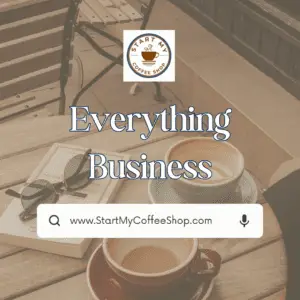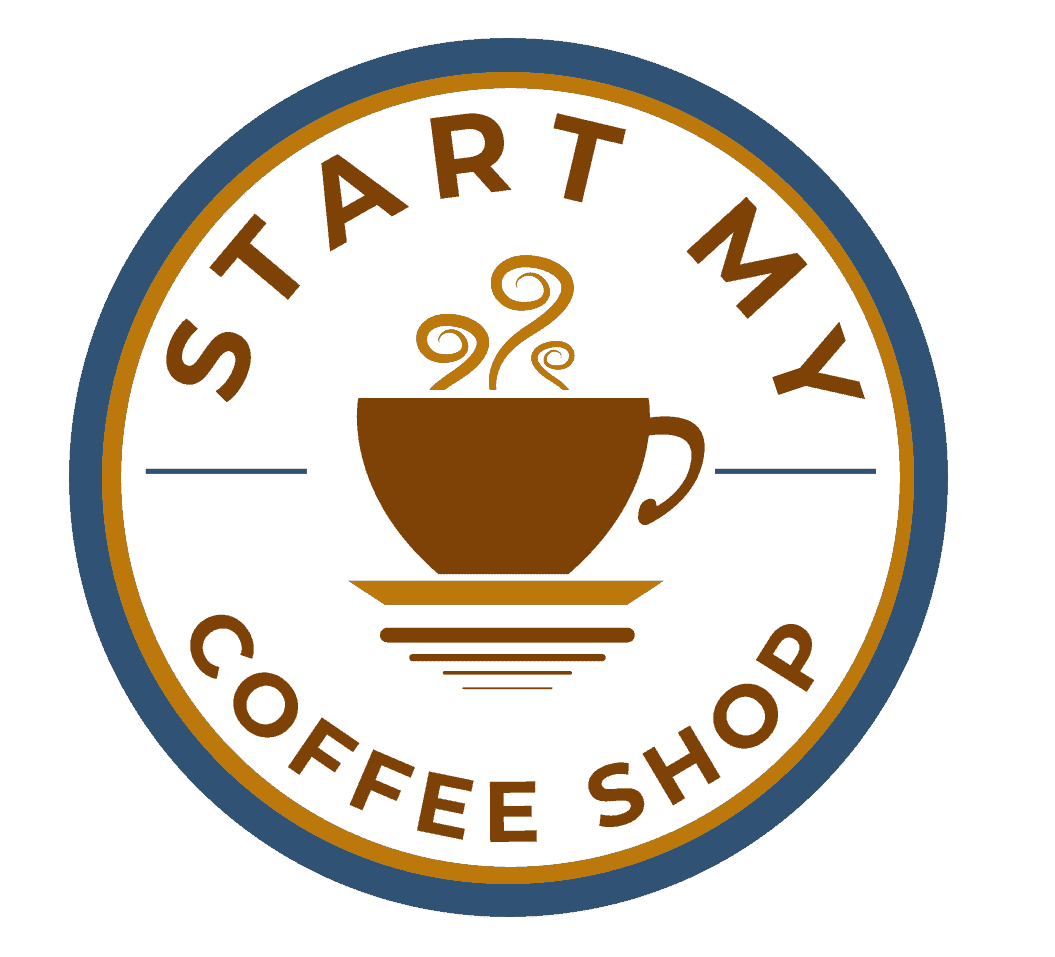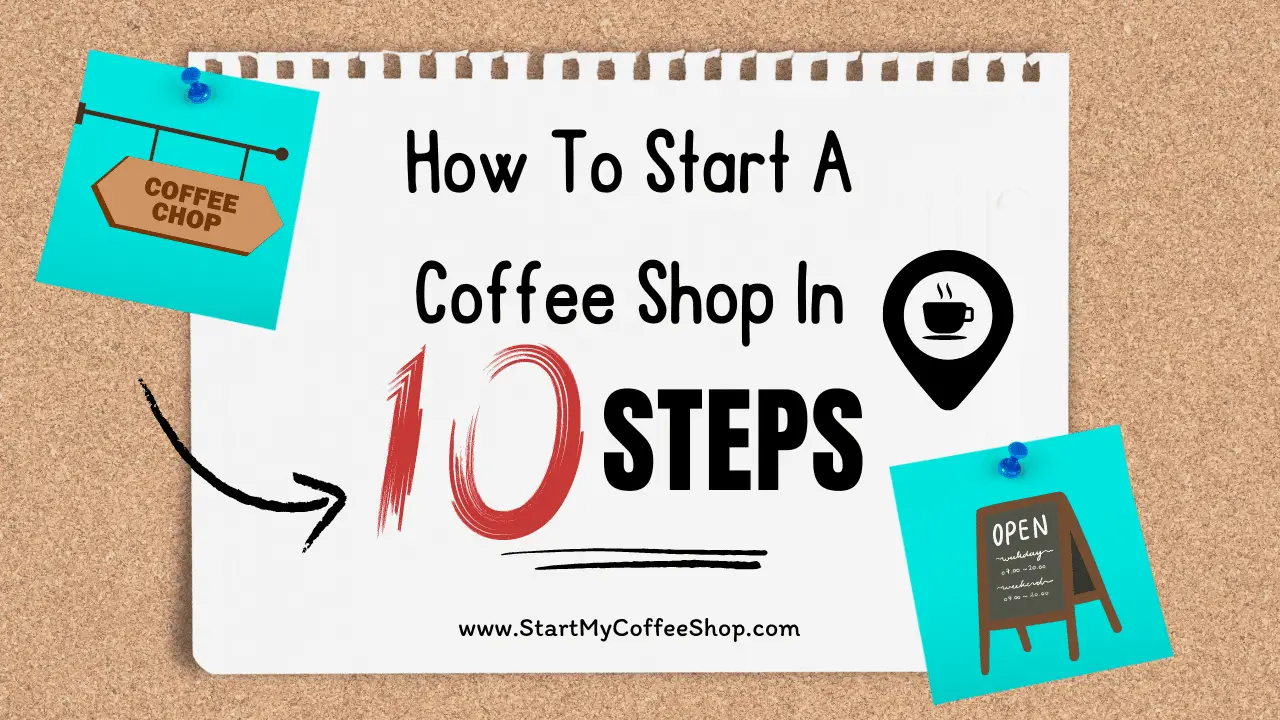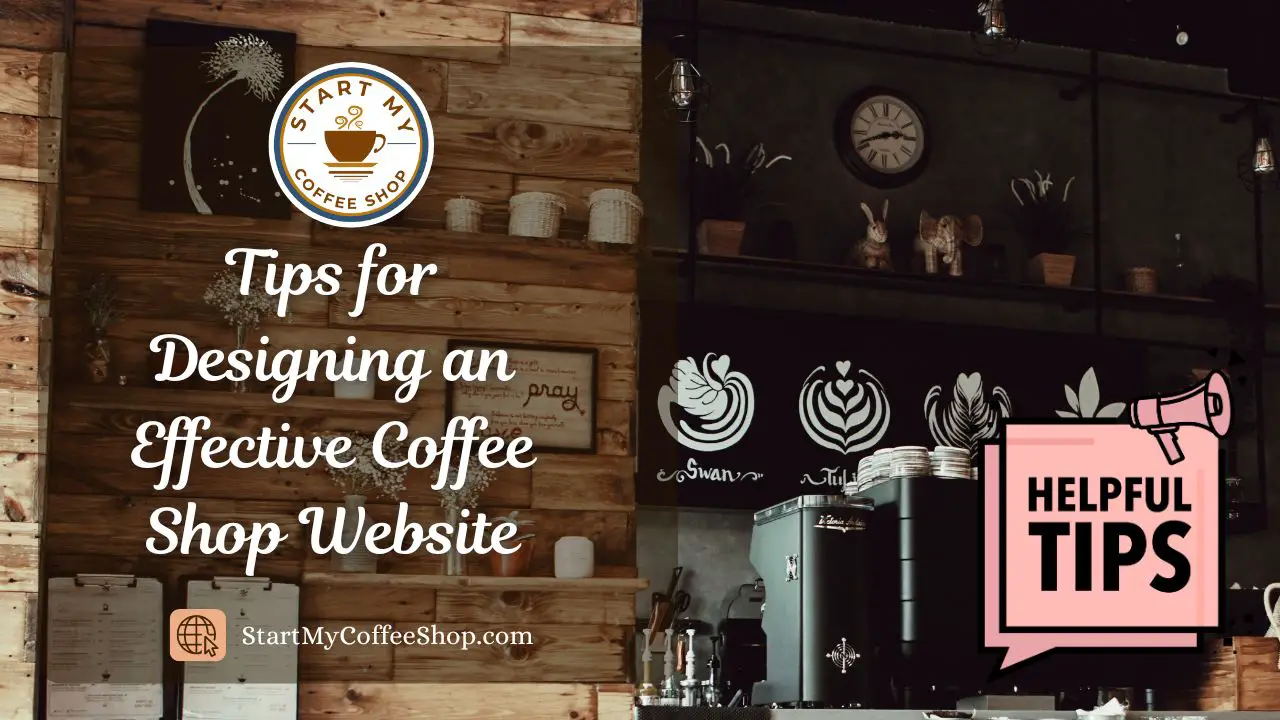Are you drinking your favorite coffee right now, puzzling over how to open up a coffee shop? This can seem like a daunting task. However, taking it step by step will help your coffee shop dream become a reality.
Here are 10 steps to follow to open up a coffee shop:
- Finance the business
- Write the business plan.
- Make timelines for all of your tasks.
- Educate yourself on the industry.
- Scout the competition and choose a location.
- Research and purchase coffee shop equipment.
- Find vendors and figure out product pricing.
- Learn the laws and regulations of operating a coffee shop.
- Hire experienced staff.
- Expect the unexpected.
If you want to start your own coffee shop business or just want to learn about the business side of things, this article is for you. So grab a cup of Joe, settle in, and take some notes.
Money, Money, Money
Like any other business, your startup costs can vary depending on what kind of shop you’re interested in or your budget for the venture. The most popular types of coffee shops are kiosks, mobile coffee shops (like a food truck, but for coffee!), a drive-thru coffee shop, and freestanding coffee shops (no drive-thru available).
Average startup costs for each type of coffee shop are listed below.
- Kiosks: $20,000-$50,000
- Mobile coffee shop (truck): $15,000-$80,000
- Drive-thru unit: $20,000-$250,000
- Freestanding shop: $60,000-$150,000
Now, I know those price ranges seem pretty large, but a lot goes into pricing including location, size of your shop, equipment, and etcetera. We’ll discuss more about that later.
Once you select the type of coffee shop that is best for you, look into how much you’ll need to borrow and how much you’ll need to break even. You must not forget to have some money set aside as a safety net on the rare occasion that some unforeseen fee or cost comes up.
While you’re at it, open up a business account. To open a business bank account, you will need to get an EIN, an official name for your shop, and a finalized business structure available for the bank of your choice. It’s also highly suggested to put the bank account in your coffee shop’s official name to make tax time way easier (who wouldn’t want that?).
Lastly, please make sure your personal finances are in order. You don’t want to put all of your money (and some of the bank’s money) into this business, have it crash and be financially screwed.
You need to make boundaries between yourself as a business owner and as a human who needs to take care of yourself and your family as well. Double, triple and quadruple check your personal finances before taking on a big venture like a business.
Everything Business

One of your best friends during this experience will be your business plan. You can write one on your own, find a free template online, or hire someone on websites like Fivver or Upwork to write it for you. A business plan will help you with your budget and finances.
You’ll need it for yourself but also to show investors at the bank and the property manager the space you end up renting or buying. The best part is that a business plan will save you so much time in the long run. It can seem like a daunting task, but your future self will thank you.
We mentioned earlier about the different kinds of shops you can open. You’ll need to know that to make your business plan work and allow yourself to budget correctly.
One of the other parts of the business is establishing yourself. Most businesses will do this by getting themselves licensed as a corporation, partnership, and most popularly LLC. Part of choosing which one is best for your business is a personal choice it also depends on what kind of business you’re opening.
In the US and Canada, the majority of coffee shops list themselves as LLCs. (Speaking of Canada, if you want to know how to open a shop there, get some insight in this article.)
One of the most fun parts of opening up a business is branding. Ask yourself these questions as you think about branding for your coffee shop:
- Who are you as a business?
- Who is your target demographic?
- What do you want someone to think when they walk in for the first time or see someone post a picture on social media?
Again, if this seems daunting to you, take a deep breath and remember you can always hire someone to do this part for you. For your branding, you’ll need to think of color schemes, interior design (if you choose a brick-and-mortar shop), your brand logo, and even a company slogan!
Once you have all of this finished, you’ll have just about everything you need to open up a website for your coffee shop. Maybe equally as important as a website is social media. Coffee shops thrive off of social media.
It’s extremely trendy to post photos of latte art inside modern, industrial-looking coffee shops or have media influencers repping your brand somehow, whether that’s a post of a well-done rosetta on a cappuccino or your newest (and coolest) coffee shop T-shirt.
Timelines
This one is pretty simple compared to the rest of the list. Make yourself a timeline (or several) of all the tasks needed to get completed. This will keep you more focused, determined, and organized. I think it’s easier and less stressful to create a new timeline for each big task.
For example, make one for the money section we first talked about. Include things like opening a business account and making a budget and dates you’d like those done by. A lot of tasks on timelines can be done on the same day to make your workload even smaller and again, free up time in the future.
Get Educated
This one might seem like a no-brainer, but I assure you that it is not. I once worked for a guy who opened up a coffee shop knowing nothing about coffee but saw its money-making potential.
Please note that the coffee industry is so much more than the average consumer would think. Know the history of coffee and the difference between arabica and robusta.
Depending on where your shop is located, you and your staff can get some pretty well-educated guests in your shop who will have pretty specific questions about what you’re serving. I once had a guy ask me the exact elevation our espresso was picked and harvested.
An easy way to educate yourself is by reading books about coffee itself. Even if reading isn’t really your cup of tea – or cup of Joe in this case – I highly suggest going to coffee cuppings, latte art throwdowns, and seminars if available. Talk with roasters and established coffee shop owners.
Most are happy to sit down and chat and hey, you may even get a free latte out of the deal! You can also easily find videos online and articles with so many helpful tips. You’re here reading this article so that means you’re already educating yourself! Pat yourself on the back.
The Market and Location

So along with branding your business, learning the market can be fun and educational all at once. This is where you can spend time going to different coffee shops in the neighborhoods you’re looking into opening up around.
Bring a friend or family member to come and taste with you. If you wanna kill two birds with one stone, you could even meet with business partners and investors for coffee all while testing out the goods and seeing what could be your future competition. If you find a roast you really like, consider grabbing a bag of coffee on the way out and visiting the roaster if they’re local.
Find out what different roasters charge wholesale per bag and usually they’ll offer a free coffee cupping for you. If you’re planning to roast your own beans, good on you, it’ll save you massive amounts of money in the long run. You can also visit shops specifically that roast their own beans and check out what’s needed for adding that into your shop.
When it comes to location, a big part of where you choose will be budget-based. Rent can dramatically increase in one neighborhood versus another 4 blocks over. On top of that, you’ll obviously be choosing partially based on what the space looks like (or has the potential to look like) inside, remember your branding from earlier.
A sneaky trick I’ve known someone to use is going to a coffee shop or business that’s similar in a potential neighborhood and actually counting the number of customers that come in at different times of the day and different days of the week to see how to foot traffic realistically is around that neighborhood.
Make sure that the customers are the same type of customers that would enter your type of shop as well. You wouldn’t open a kids’ clothing store in a neighborhood that’s mostly college-aged versus a neighborhood of young families, would you? Be smart, do your research and have fun with it after all these shops you visit could be your competition.
Lastly when it comes to the market, make sure your business has a very strong Unique Sales Proposition, or USP. In layman’s terms, what is going to draw people to your shop instead of the chain coffee shop they’re so used to? What makes you different than the shops you visited when doing your research? What makes your shop stand out?
Equipment
Getting equipment for the shop can be a really fun experience. Since, at this point, you’ll already have your branding and budget down, it’ll be a breeze. Equipment covers everything from point-of-sale (POS), mugs, tables, espresso machines, and so on. It can be overwhelming because there is so much to buy, but with your timelines and task lists, a lot of the stress can be taken away.
Do not buy the cheapest equipment to save money at the moment. Not only with the wear and tear will it break much sooner than you expect, you’ll need to buy another one and you’ll lose sales while waiting for replacement equipment to come in. Spend the time and money finding quality equipment for the kind of shop you’re opening.
This is another opportunity to educate yourself about the industry. Think about answers to the following questions when choosing equipment for your coffee shop:
- Do you need just an espresso machine?
- What kind of pour-over system will you be using?
- Will you offer brewing methods like Chemex, French Press, or Aeropress?
You must decide on a point-of-sale (POS) to use. Your POS system is also known as a cash register. With all the coffee shop hopping you did in your market and neighborhood research, you probably noticed most shops use iPads or electronic registers.
Whichever you choose, like most things in this article, should be based upon what kind of shop you’ll be opening and your branding. This is another area where what you decide will either make your life with accounting and inventory much easier or slowly drain you.
Some of the most successful privately-owned coffee shops I know use Square. It’s worth looking into, and their systems keep track of more than most people can think of when it comes to register capabilities.
Vendors and Pricing
One of the biggest things for your shop is the menu. Your menu helps determine your budget, your equipment, branding, marketing, and, well…everything. Think about these questions as you create your coffee shop menu:
- Are you going to have different milk substitutes?
- If so, what kinds, and how many?
- Will your shop only have a few flavors?
- Are they made in-house or outsourced?
- Will you have food?
- If so, how much, and what kind?
See what I mean? There is so much involved in creating a menu!
My advice is to start simple. Start with your espresso basics: espresso, macchiato, cortado, cappuccino, and latte. Then, maybe add a few different teas, bottles of water, and a cold brew or iced coffee. As your business gets rolling, see what customers want. Are you seeing a lot of people asking for an orange juice they can take with them to work?
Maybe your shop is by a yoga studio and your customers are asking for kombucha. If you start with the basics and add on as you see what’s being requested, it’ll take a weight off your shoulders and the guests will see you’re listening to their wants and needs.
When it comes to vendors, the biggest advice you’ll hear is to go local. If you choose a vendor that is local to where your shop will be, many of your guests will already be familiar with and most likely fans of the vendor you choose. Plus, are small businesses supporting small businesses? Guests LOVE that kind of stuff.
One of the biggest avenues for vendors in independent coffee shops is pastries. To me, this sounds like another reason to go out trying different donuts and muffins. Score! When partnering with a vendor, you’ll be asking questions about their wholesale prices, their delivery schedules and policies, and even asking about gluten-free and vegan options.
Be sure to ask as many questions and try as many products as possible. Again, start simple and see what kind of coffee and food options your regulars would like to see added to your pastry menu.
Laws & Regulations

Before opening up shop you’ll want to research the taxes, codes, and regulations in the neighborhood you chose. This can drastically change in numbers and what is required before opening up depending upon where your shop will be located down to the block it’s on so when doing your research be as specific as possible.
For example, Minneapolis doesn’t allow outside food or beverage in coffee shops yet, but people can bring their dogs inside. Yet Saint Paul, the other of the Twin Cities, is the opposite with their health code; outside food and beverage is okay, but dogs must be service animals.
Again, look as specifically as you can for the location of your shop. Remember that the people who determine if your shop is up to code want you to be successful. Just follow the tasks needed to check off their boxes and you’ll be good to go.
Staff
Who you hire can make or break your business. Make sure your baristas get all the required training needed to be successful, whether that’s milk steaming training (yes, that’s a thing), the history of coffee, training in different brewing methods, etc.
Teaching latte art can give your baristas something fun to practice during downtime and at the same time end up impressing your guests. Seriously, I’ve seen people buy a latte to literally just take a photo of it!
When hiring, remember that experience matters but trainability and personality can go very far. Your staff are some of the first people your guests will interact with before they start their day. Hence, you want to make sure your staff is happy, taken care of, and, in turn, can take care of your customers.
Expectations
Before you run off and start your business, I have to be the one to say it: Expect the unexpected. Have extra saved in the bank, know that there are a lot of little decisions you may not see coming. Go with your gut (and your budget).
If this is your first business, there will be hiccups, and that’s okay. You’ve learned so much, and if your shop is already open by the time the hiccups start, then holy cow, good for you! You opened up a coffee shop! Never be afraid to ask for help, and enjoy the ride. Cheers!
Frequently Asked Questions
How can I start a coffee shop with no money?
According to the Coffee Shops Startup blog, crowdfunding is the most popular way to start a coffee shop with no money. After writing the business plan and setting a target for startup costs, create a website and social media accounts for your coffee shop to receive support from people.
What are some coffee shop business ideas?
Besides the 4 types of coffee shops discussed in this article, there are other business ideas to help you start small with little startup cost. Read more about these ideas at the Coffee Shop Startups blog:
- Sell goods at a farmer’s market such as coffee beans and pastries.
- Find a business that will give you a shared space for a small rental fee.
- Open up a coffee business online. You can sell products such as ground coffee, coffee beans, K cups, gourmet pastries, and etcetera.
Want more insight into opening your own coffee shop? Click here for even more details.
Please note: This blog post is for educational purposes only and does not constitute legal advice. Please consult a legal expert to address your specific needs.

Hi! I’m Shawn Chun
My adventure in coffee began when I first launched my first coffee shop back in the early 2000s. I had to figure out so many things on my own and to make it worse within 2 years of opening two large corporate coffee chains moved in just blocks away from me!
As I saw smaller and even some larger coffee shops in the neighborhood slowly lose customers to these giant coffee chains and slowly close up shop, I knew that I had to start getting creative…or go out of business.
I (like you may be) knew the coffee industry well. I could make the best latte art around and the foam on my caps was the fluffiest you have ever seen. I even had the best state-of-the-art 2 group digital Nuova Simonelli machine money could buy. But I knew that these things alone would not be enough to lure customers away from the name brand established coffee shops.
Eventually, through lots of trial and error as well as perseverance and creativity I did find a way to not only survive but also thrive in the coffee/espresso industry even while those corporate coffee chains stayed put. During those years I learned to adapt and always faced new challenges. It was not always easy, however, in the end, I was the sole survivor independent coffee shop within a 10-mile radius of my location. Just two corporate coffee chains and I were left after that year. All told the corporate coffee chains took down over 15 small independent coffee shops and kiosks and I was the last one standing and thriving.
Along the years I meet others with the same passion for coffee and I quickly learned that it is not only “how good a barista is” that makes a coffee shop successful, but the business side of coffee as well.
Hence why I started this website you are on now. To provide the tools and resources for up and coming coffee shop owners to gain that vital insight and knowledge on how to start a coffee shop successfully.
Stick around, browse through my helpful blog and resources and enjoy your stay! With lots of LATTE LOVE!
Shawn






